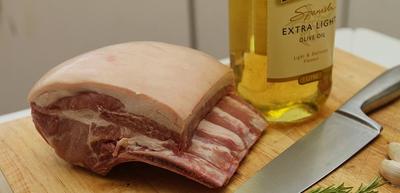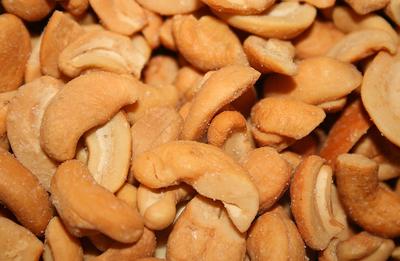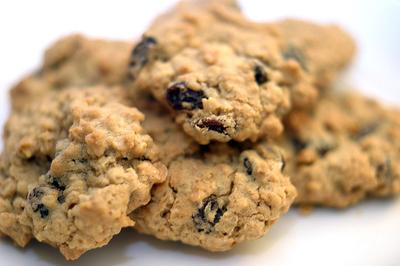Advertisement
Resident Chef Kathy Gunst Says Cookbooks Got Gigantic In 2010
Resume
We asked our resident chef Kathy Gunst to pick her favorite cookbooks of the year, and her choices are especially hefty. There's Dorrie Greenspan's 544-page opus, "Around My French Table," along with 336-page "Stir-Frying to the Sky's Edge" by Grace Young, Rachel Saunders' 384-page "The Blue Chair Jam Cookbook," "Flour: Spectacular Recipes from Boston's Flour Bakery + Cafe" by Joanne Chang and Christie Matheson and "One Big Table: A Portrait Of American Cooking" by Molly O'Neill.
Below, see recipes from those books, including: Pork Roast with Mangoes and Lychees, Cashew Chicken, Strawberry-Blood Orange Marmalade with Rosemary, Oatmeal Raisin Cookies.
Kathy also recommends, "The Gourmet Cookie Book: The Single Best Recipe from Each Year 1941-2009," by Gourmet Magazine; "In the Kitchen with A Good Appetite: 150 Recipes and Stories About the Food You Love," by Melissa Clark; "Ready for Dessert: My Best Recipes," by David Lebovitz and "What I Eat: Around the World in 80 Diets," by Peter Menzel and Faith D'Aluisio.
- Leave a comment
- Here & Now: Read more holiday recipes
- Notes From A Maine Kitchen: Read Kathy's blog
- Stonewall Kitchen: Read Kathy's recent cookbook
Pork Roast with Mangoes and Lychees(pdf)
Makes 4 to 6 servings

[sidebar title="Cook's Note" width="475" align="right"]My friend Alec Lobrano is the man thousands turn to when they want advice on where to eat in Paris. The author of "Hungry for Paris" and a longtime contributor to Gourmet magazine, he’s been the go-to guy on the Paris scene for more than twenty-five years. Yet while Alec can detect and describe the nuances of French cuisine from classic to nouvelle, when he’s cooking at home, he’s apt to serve his French friends something from his earlier life in America, often this sweet-and-sharp pork loin, a dish with roots in the Dominican Republic.
Alec tells a wonderful story of moving to New York’s Upper West Side in 1977, where he shared an apartment with a friend who was as broke as he was, and discovering a neighborhood Dominican bar where the air-conditioning was reliable, the beer cheap, and the welcome — once the crowd got used to the gringos — warm, so warm that when Dominican Independence Day rolled around, Alec found himself invited to celebrate with the bar’s owner. It was there that he had a version of this dish: pork and mangoes in a wine and vinegar sauce with soy and honey. It must have been love at first taste, because he has carried the memory and the recipe with him ever since, first to London and then to Paris, where it seems perfectly at home.
Alec told me that when he re-created this roast, he added the lychees, which, as he says, “have the oddball fun of standing in for the fat that’s missing from a pork loin. People always think that the lychees are fat and push them to one side, so I love revealing the trompe l’oeil and insisting they try at least one.” [/sidebar]
1 2- to 2½-pound pork loin roast, at room temperature
2 tablespoons olive oil
Salt and freshly ground pepper
1 large onion, finely chopped
5 garlic cloves, split, germ removed, and thinly sliced
3 tablespoons red wine vinegar
½ cup dry white wine
3 tablespoons soy sauce
Juice of 1 lime
3 tablespoons honey
½–1 teaspoon piment d’Espelette (see Sources) or chili powder
1 bay leaf
2 thyme sprigs
1 ripe mango, peeled, pitted, and cut into thin strips
10 lychees, peeled and pitted if fresh, drained if canned
Center a rack in the oven and preheat the oven to 300 degrees F.
Pat the roast dry with paper towels. Place a Dutch oven or other heavy oven-going casserole over medium-high heat and pour in 1 tablespoon of the oil. When it’s hot, put the pork fat side down in the pot and cook for a couple of minutes, until the fat is browned, then turn it over and brown the other side. Transfer the roast to a plate, season with salt and pepper, and discard the oil.
Return the pot to the stove, this time over low heat, and add the remaining tablespoon of oil. When it’s warm, toss in the onion and garlic, season with salt and pepper, and cook, stirring, for about 3 minutes, or until the onion is translucent. Turn up the heat and pour in the vinegar — stand back, the scent of hot vinegar is very strong. When the vinegar has almost evaporated, a matter of a minute or two, pour in the wine. Let the wine bubble for 30 seconds or so, then add the soy, lime juice, and honey. Bring to a boil, stir in the piment d’Espelette or chili powder, add the bay leaf, thyme, mango, and lychees, and give the pot another minute at the boil. Add the roast fat side up, baste with the sauce, cover the casserole, and slide it into the oven.
Allow the roast to braise gently for 30 minutes, then check its temperature: you’re looking for it to measure 140 degrees F at its center on an instant-read thermometer. The roast is likely to need a total of 40 to 50 minutes in the oven, but it’s important to check early, since pork varies. Pull the pot from the oven, transfer the roast to a cutting board, cover it lightly with a foil tent, and let it rest for 5 to 10 minutes, during which time it will continue to cook (its temperature will probably rise another 5 degrees or so).
While the roast is resting, taste the sauce. If you’d like to concentrate the flavors even more, boil it for a couple of minutes. Don’t forget to check for salt and pepper.
Slice the roast and serve with the sauce.
Serving
Alec serves his pork with sticky rice, but I like it as much with Cardamom Rice Pilaf —the citrusy flavor of the cardamom is really nice with the fruit in the sauce — or Orange Rice Pilaf.
Storing
Leftovers can be covered and refrigerated overnight, then reheated very gently the following day, but it’s likely that the pork will be a tad overcooked. You can use the pork chilled in salads or let it come to room temperature and make open-faced sandwiches. Do that, and you should reheat the sauce and spoon it over the sandwiches. Speaking of the sauce, it’s great over pasta.
Excerpted from Around My French Table by Dorie Greenspan. Copyright © 2010 by Dorie Greenspan. Reprinted by permission of Houghton Mifflin Harcourt Publishing Company. All rights reserved.
Cashew Chicken (pdf)
Serves 2 to 3 as a main course with rice or 4 as part of a multicourse meal.

[sidebar title="Cook's Note" width="475" align="right"]In America, cashew chicken is one of the most beloved dishes served in Chinese restaurants. Sadly it is often “Westernized,” with deep-fried pieces of chicken in a heavy gravy. A true Cantonese cashew chicken should be seasoned with ginger, stir-fried with fresh sugar snaps, carrots, and celery, all in a light sauce that barely clings to the chicken. Look for fresh cashews of the best quality. I often buy unroasted cashews and dry stir-fry them in a dry skillet or wok over medium heat a few minutes, shaking the pan frequently until they are just light golden. For a richer tasting sauce use dark soy sauce in place of regular soy sauce with the broth. The virtues of a “simple” stir-fry are demonstrated in this easy-to-make recipe.[/sidebar]
1 pound skinless, boneless chicken thigh, cut into 1∕2-inch cubes
1 tablespoon minced garlic
2 teaspoons soy sauce
11∕2 teaspoons cornstarch
1 teaspoon plus 2 tablespoons Shao Hsing rice wine or dry sherry
3∕4 teaspoon salt
1∕8 teaspoon sugar
1∕4 cup chicken broth
2 tablespoons peanut or vegetable oil
2 tablespoons minced ginger
1∕2 cup sugar snap peas, strings removed
1∕2 cup thinly sliced carrots
1∕2 cup thinly sliced celery
1∕2 cup unsalted roasted cashews
1. In a medium bowl combine the chicken, garlic, 1 teaspoon of the soy sauce, 1 teaspoon of the cornstarch,1 teaspoon of the rice wine, 1∕2 teaspoon of thesalt, and sugar. Stir to combine. In a small bowl combine the broth, the remaining 1 teaspoon soy sauce, 2 tablespoons rice wine, and 1∕2 teaspoon cornstarch.
2. Heat a 14-inch fl at-bottomed wok or 12-inch skillet over high heat until a bead of water vaporizes within 1 to 2 seconds of contact. Swirl in 1 tablespoon of the oil, add the ginger, then, using a metal spatula, stirfry10 seconds or until the ginger is fragrant. Push the ginger to the sides of the wok, carefully add the chicken, and spread it evenly in one layer in the wok. Cook undisturbed 1 minute, letting the chicken begin to sear. Stir-fry 1 minute, or until the chicken is lightly browned but not cooked through.
3. Swirl the remaining 1 tablespoon oil into the wok, add the sugar snaps, carrots, celery, and cashews, and sprinkle on the remaining 1∕4 teaspoon salt. Stir-fry 1 minute or until the sugar snaps are bright green. Restir the broth mixture, swirl it into the wok, and stir-fry 1 minute or until the chicken is just cooked through.
From “Stir-Frying To The Sky’s Edge” by Grace Young. Copyright © 2010 by Grace Young. Reprinted by permission of Simon & Schuster, Inc, NY.
Strawberry-Blood Orange Marmalade with Rosemary (pdf)
Approximate Yield: six to seven 8-ounce jars. Shelf Life: 1 year
[sidebar title="Cook's Note" width="475" align="right"]This excellent marmalade is gorgeous to behold, with its strips of orange rind shimmering in brick red jelly. The different ingredients come together perfectly into an exquisitely rich bouquet. It is a breathtaking use for early-season strawberries and is extremely versatile; breakfast toast, lunch sandwiches, tart fillings, and after-dinner cheese are but a few of its many delectable uses.[/sidebar]
2 1/4 pounds hulled strawberries
1 1/2 pounds seeded Moro blood oranges, halved crosswise, each half cut into quarters lengthwise and sliced crosswise medium-thin
2 (8-inch) sprigs rosemary
2 pounds 10 ounces white cane sugar
2 to 4 ounces strained freshly squeezed lemon juice
Day 1
First, prepare the strawberry juice: Place the strawberries in a medium stainless-steel kettle and add enough cold water to just cover the tops of the fruit. Bring to a boil over high heat, then decrease the heat to a simmer. Cover and cook the fruit for 1 to 1½ hours, or until the berries are brown and shapeless and the liquid has become syrupy.
Strain the strawberry juice by pouring the hot fruit and liquid into a medium-fine-mesh strainer sus-pended over a heatproof storage container or nonreactive saucepan. Cover the entire setup well with plastic wrap and place in the refrigerator to drip overnight.
While the strawberries are cooking, place the orange slices in a separate nonreactive saucepan with water to reach 1 inch above the tops. Cover tightly and let rest overnight at room temperature.
Day 2
Place a saucer with five metal teaspoons in a flat place in your freezer for testing the marmalade later. Rinse the rosemary well under cold water, pat it dry between two clean kitchen towels, and set aside.
Bring the pan with the orange slices to a boil over high heat, decrease the heat to medium, and cook, covered, at a lively simmer for 30 to 60 minutes, or until the fruit is very tender. If necessary, add a little more water during the cooking; the fruit should remain submerged throughout the cooking process.
While the orange slices are cooking, remove the plastic wrap from the strawberries and their juice and discard the berries. Strain the juice well through a very fine-mesh strainer to remove any lingering solids.
When the orange slices are ready, place them in a large mixing bowl with the sugar, cooked strawberry juice, and 2 ounces lemon juice, stirring well.
Taste, and slowly add a little more lemon juice if necessary. You should be able to taste the lemon juice, but it should not be overpowering. Keep adding lemon juice only until you are just able to detect its tartness in the mixture. Transfer the mixture to an 11- or 12-quart copper preserving pan or a wide nonreactive kettle.
Bring the mixture to a boil over high heat. Cook at a rapid boil until the setting point is reached; this will take a minimum of 35 minutes, but may take longer depending on your individual stove and pan. Initially, the mixture will bubble gently for several minutes; then, as more moisture cooks out of it and its sugar concentration increases, it will begin foaming. Do not stir it at all during the initial bubbling; then, once it starts to foam, stir it gently every few minutes with a heatproof rubber spatula. As it gets close to being done, stir it slowly every minute or two to prevent burning, decreasing the heat a tiny bit if necessary. The marmalade is ready for testing when its color darkens and its bubbles become very small.
To test the marmalade for doneness, remove it from the heat and carefully transfer a small representative half-spoonful to one of your frozen spoons. It should look shiny, with tiny bubbles throughout. Replace the spoon in the freezer for 3 to 4 minutes, then remove and carefully feel the underside of the spoon. It should be neither warm nor cold; if still warm, return it to the freezer for a moment. Tilt the spoon vertically to see whether the marmalade runs; if it does not run, and if its top layer has thickened to a jelly consistency, it is done. If it runs, cook it for another few minutes, stirring, and test again as needed.
When the marmalade has finished cooking, turn off the heat but do not stir. Using a stainless-steel spoon, skim off any surface foam and discard. Place the rosemary into the mixture and let steep for a few minutes off the heat. Stir and carefully taste the marmalade. Remove the sprigs or leave them in for another minute or two, keeping in mind that their flavor will be slightly milder once the marmalade has cooled. Using tongs, discard the rosemary. Pour the marmalade into sterilized jars and process according to the manufacturer’s instructions.
From “The Blue Chair Jam Cookbook” by Rachel Saunders/Andrews McMeel Publishing
Oatmeal Raisin Cookies (pdf)
Makes about 24 cookies

[sidebar title="Cook's Note" width="475" align="right"]Professional pastry chefs often overlook simple recipes. We are all out to prove that we can create magic out of butter, sugar, flour, and eggs—which we can! But sometimes we are so determined to develop intricate methods and combine esoteric ingredients to prove our prowess that we go overboard. When it comes to oatmeal raisin cookies, I’ve found that the best recipe is the one that allows the pure and delicious flavor of nutty oats and plump raisins to shine through. This recipe is as basic as it gets. It has a slight hint of spice from freshly grated nutmeg (this is crucial—buy a whole nutmeg, use a grater, and let the smell transport you to sipping eggnog by a roaring fire) and a little bit of ground cinnamon. But mostly it is an addictive mix of chewy cookie and sweet raisins.[/sidebar]
1 cup (2 sticks/228 grams) unsalted butter, at room temperature
3/4 cup (150 grams) granulated sugar
1 cup (220 grams) packed light brown sugar
2 eggs
13/4 cups (245 grams) unbleached all-purpose flour
13/4 cups (175 grams) old-fashioned rolled oats (not instant or quick cooking)
1 teaspoon baking soda
1 teaspoon kosher salt
1/4 teaspoon freshly grated nutmeg
1/4 teaspoon ground cinnamon
11/2 cups (240 grams) raisins
If you are baking the cookies on the same day you are preparing the dough, position a rack in the center of the oven, and heat the oven to 350 degrees.
Using a stand mixer fitted with the paddle attachment (or a handheld mixer or wooden spoon), cream together the butter, granulated sugar, and brown sugar on medium speed for about 5 minutes, or until the mixture is light and fluffy. (This step will take 10 minutes if using a handheld mixer or a spoon.) Stop the mixer a few times and use a rubber spatula to scrape the sides and bottom of the bowl and the paddle to release any clinging butter or sugar. Beat in the eggs on medium speed for 2 to 3 minutes, or until thoroughly combined. Scrape the bowl and the paddle again to make sure the eggs are thoroughly incorporated.
In a medium bowl, stir together the flour, oats, baking soda, salt, nutmeg, and cinnamon. Add the raisins and toss to combine. On low speed (or with the wooden spoon), slowly add the flour mixture to the butter-sugar mixture and then mix just until the flour mixture is totally incorporated and the dough is evenly mixed.
For the best results, scrape the dough into an airtight container and let it rest in the refrigerator overnight (or for at least 3 to 4 hours) before baking. When ready to bake, position a rack in the center of the oven, and heat the oven to 350 degrees F.
Drop the dough in 1/4-cup balls onto a baking sheet, spacing them about 2 inches apart. Flatten each ball slightly with the palm of your hand.
Bake for 20 to 22 minutes, or until the cookies are golden brown on the edges and slightly soft in the center. Be careful not to overbake. Soft, chewy centers make these cookies irresistible. Let cool on the baking sheet on a wire rack for 5 to 10 minutes, then transfer the cookies to the rack to cool completely.
The cookies can be stored in an airtight container at room temperature for up to 3 days. The unbaked dough can be stored in an airtight container in the refrigerator for up to 1 week.
From Flour: Spectacular Recipes from Boston’s Flour Bakery + Café by Joanne Chang with Christie Matheson, Chronicle Books (2010)
This segment aired on December 21, 2010.